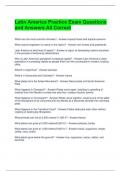Latin America Practice Exam Questions
and Answers All Correct
Which are the most common climates? - Answer-tropical forest and tropical savanna
What natural vegetation is mainly in the region? - Answer-rain forests and grasslands
Latin America is what kind of region? - Answer-a region of developing nations-countries
in the process of becoming industrialized.
Why is Latin America's population increasing rapidly? - Answer-Latin America's urban
population is increasing rapidly as people flock from the countryside to modern, busting
cities.
What's in Argentina? - Answer-pampas
What's in Venezuela and Colombia? - Answer-Llanos
What plates form the Andes Mountains? - Answer-Nazca plate and South American
Plate
What happens in Divergent? - Answer-Plates move apart, resulting in upwelling of
material from the Mantle to create new sea floor; creates volcanic activity.
What happens in Convergent? - Answer-Plates move together, causing one of the slabs
of the lithosphere to be consumed into the Mantle as it descends beneath the overriding
plate.
What happens in the Transform Fault? - Answer-Plates slide past each other without
creating or destroying lithosphere.
What animals can live at 3,500 meters/11,500 ft? - Answer-llamas
What plants can grow at 2,000 meters/6,500 ft.? - Answer-potatoes, barley
What plants can grow at 1,000 meters/3,000 ft.? - Answer-maize, sugarcane, wheat,
coffee, coca, cotton
What plants grow below the ground? - Answer-rice, sugarcane, cacao, rubber, and
bananas.
, Why does Latin America have such a rugged landscape? - Answer-because much of
the region sits along the Pacific Region of Fire.
Andes Mountains - Answer-the Andes is composed by 4.5000 mile stretch along the
western edge of South America. Their extent makes de Andes the longest mountain
range, as well as one of the highest with some peaks rising to more than 20,000 feet
above the sea level.
How have the Andes Mountains have play an important role in the development of
South America? - Answer-The Andes play a vital part in national economies, accounting
for a significant proportion of the region's revenue, providing large agricultural areas,
mineral resources, and water for agriculture, hydroelectricity, domestic use, and some
of the largest business centers in South America.
The region is highly diverse in terms of what? - Answer-in terms of landscape,
biodiversity including agro-biodiversity, languages, peoples and cultures. Such varied
conditions have led to a vast pool of knowledge, often undervalued, but of great
importance, for example in for climate change adaptation strategies and measures.
Why is it important? - Answer-It reflects a unique blend of world cultures, including
Native American, European, and African. Latin America's diverse cultures have spread
to other parts of the world.
How has Latin America influenced the US? - Answer-Their languages, music, foods,
and arts have influenced them. Many Americans are of Latin American descent and
maintain close ties to their heritage. They are also close trading partners and share
democratic values based on human rights and revolt from European rule.
How big is Latin America? - Answer-It spans more than 85 degrees of latitude; it covers
and area of about 8 million square miles, nearly 16% of the earth's surface
Which Europeans mostly settled here? - Answer-Spain and Portugal, who spoke
Spanish or Portuguese, language based on Latin, the language of the Romans, which
gives the region its name.
What countries does Latin America encompass? - Answer-Mexico, Central America, the
Caribbean Islands, and South America.
What runs throughout northern Mexico and through the heart of Central America? -
Answer-High mountains
What courses down in South America's western side? - Answer-The Andes
What dominates the landscape? - Answer-plains, great grasslands. they are ideal for
grazing cattle and sheep.




